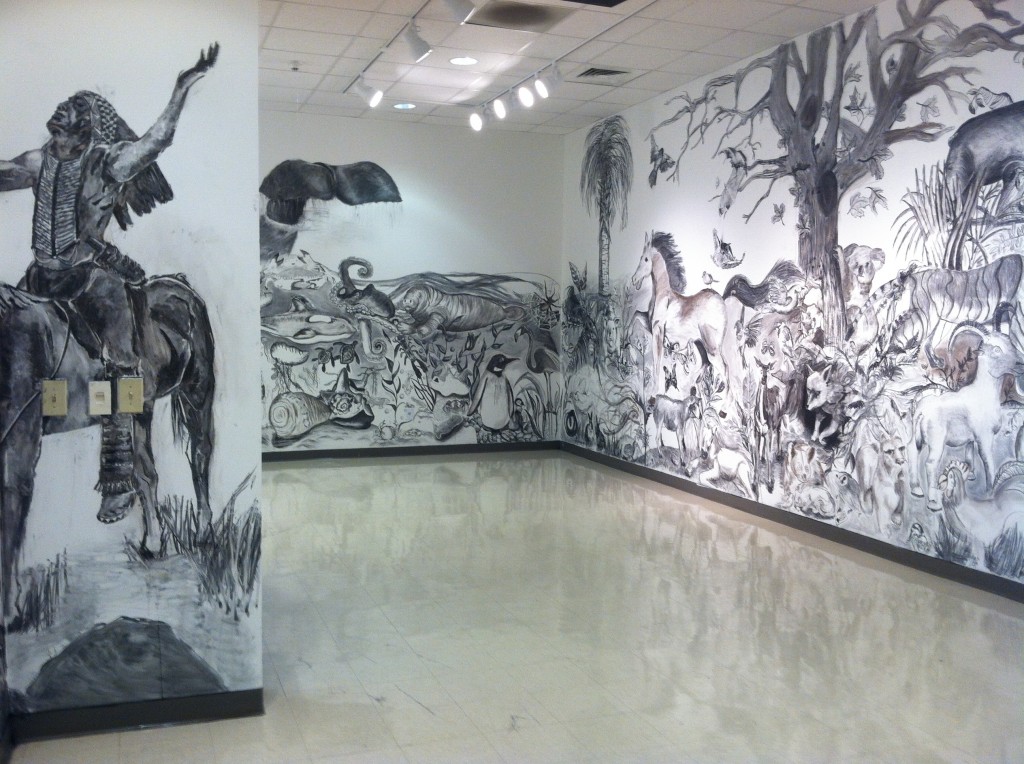Anne Simpkins’ Life Drawing class presents Evolution of Life Mural
 Anne Simpkins, associate professor of art, asked her Life Drawing class to create a mural that depicted the evolution of life. But, after her class of 14 students began communicating and collaborating with one another to complete the project, their final product portrayed not only literal evolution but the developing process of collaboration as well.
Anne Simpkins, associate professor of art, asked her Life Drawing class to create a mural that depicted the evolution of life. But, after her class of 14 students began communicating and collaborating with one another to complete the project, their final product portrayed not only literal evolution but the developing process of collaboration as well.
By challenging her students to recreate the concepts of evolution and history, Simpkins was able to teach her class about life drawing and teamwork in a unique way.
“In a lot of ways, the skill of life drawing is a practice-based thing just like learning to hit baseballs or figuring out how to use computers,” she said. “Just like anything, the more you do it, the better you are, and by working on this mural, it provided a vehicle for that practice that was varied and exciting and different.”
Simpkins’ students worked with plastic figurines, live animals, and still photographs to construct its Evolution of Life Mural using vine charcoal. The artists committed four class periods and three homework assignments to the project, and students from other drawing classes came by to contribute small pieces to the work, too.
Before beginning, Simpkins and her students determined they wanted to stick with drawing natural animals and living things, and they decided to allot one portion of the mural to early life in the Precambrian or Proterozoic era before moving into water and dinosaurs. Next, they decided to draw land animals and then larger land animals, such as elephants, giraffes, and big cats, before moving into human life and technology.
Further, the class determined it was acceptable for them to modify, erase, and add to others’ drawings if their changes bettered the overall appearance and fluidity of the work.
“Anyone could modify anybody’s drawings, so nothing was precious,” Simpkins said. “All pieces could be altered. You could layer something over top and erase out something in order to add your layer, or you could change something that somebody had already done if you felt like it wasn’t quite jiving with the spot that you wanted.”
Though this collaborative approach was a ground rule Simpkins and her class agreed on, her students were hesitant to alter their classmates’ drawings at first.
“I think initially people were really reticent to erase other people’s work,” Simpkins said. “Initially, it was like, ‘I can’t touch that. Someone else already spent time on that.’ And it’s like, ‘No, you have to be willing to make changes.’ I think that’s at the heart of a lot of drawing. People have to be willing to make changes even if they spent time on something.”
However, as space became limited and major, individual elements of the mural were completed, students were forced to collaborate with one another. Junior Sean Walmer, a student in Simpkins’ class, said the cooperative nature of the project seemed natural after the artists had finished building a strong foundation for the mural.
“It was really just individual elements in the beginning, but a few people, myself included, put up a few notes on the wall, saying, ‘Seriously, somebody, please fix this. This is awful,’” Walmer said. “And we started working together. As space became more limited, we were forced to start doing that. It was a natural step to take. Nobody ever erased something completely, and nobody altered anything without a good reason. We just naturally overcame our hesitations, but we really had to fight it.”
Because the Evolution of Life Mural was displayed in the Elon Arts West Gallery for a limited amount of time, Simpkins said she thinks the project’s fixed exhibition schedule also helped to ease students’ concerns over perfecting their drawings.
“I think we don’t often have opportunities to do murals in a setting where we can control a subject matter entirely,” Simpkins said. “So often, murals are put up with the intention to advertise a particular thing or are driven by the owner of the facility or are created to be there permanently. The temporal nature of this really lends itself to taking chances—you don’t have to feel like it’s going to be there forever. I think that’s also a more contemporary way to think about wall art or mural art—that it’s finite in its life.”
The Elon Arts West Gallery changes its exhibits about five times a year, with each exhibition displaying for about six weeks. Though the Evolution of Life Mural has been erased, you can see graduating art students’ senior thesis projects in the Gallery any time between now and May.
 Follow
Follow


